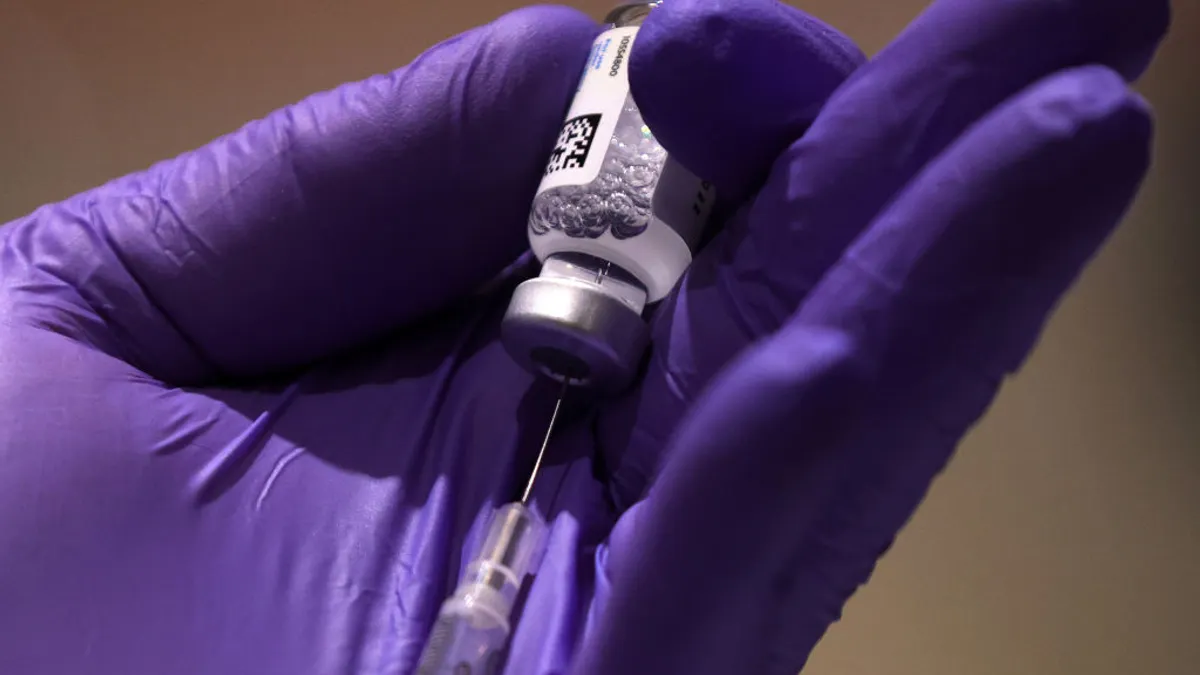There are still significant financial pressures to contend with, including regulation, cost pressures and a steep patent cliff. But in the short term, optimism abounds for the road ahead.
“We no longer talk about a rolling recession or a soft landing — the buzzword now is ‘immaculate disinflation,’” Ural said, referring to the term that indicates cooling inflation without the usual corresponding surge in unemployment. While investment is still lower than in the past decade, it’s improving.
“Overall, I think the industry is better positioned than we were 12 months ago,” Ural said.
A market snapshot
M&A volume charted an upward trend in 2023, but remained below its historical average of about $200 billion.
“If you look at the deal volume overall, we are looking at probably $213 billion,” Ural said.
“It’s currently a buyer’s market — but with an asterisk,” Ural said. Today, biotechs remain a tale of two cities: Some companies are well-funded and poised to spend, while others are biting their nails, watching cash dwindle, hoping to make it another year.
“Our research now shows about 47% of biotechs don't have cash,” Ural said, and for 27% what they do have is not enough to get them through more than a year.
Companies, contending with ongoing market volatility, are just starting to pull out their wallets after reining in discretionary spending as interest rates shot up. While it may appear to be a buyer’s market, that’s not always proving to be the case, Ural said.
Multiple bidders sometimes drive up prices for the late-stage products that are gobbling up a bigger portion of investments.
“In 2023, 60% of capital deployed toward marketed or phase 3 products,” Ural said. “That number was 59% in 2022, 52% in 2021 and 50% in 2020. So, what you saw in the last four years, the portion of M&A and the portion of capital allocated to phase 3 increased.”
These later-stage assets can garner a significant premium, he said.
Rising regulations
Two regulatory clouds could also darken the horizon — the Inflation Reduction Act (IRA) and enforcement by the Federal Trade Commission (FTC). The IRA, aimed at reducing drug costs for consumers, puts unfavorable pressure on the long-term R&D strategy, portfolio optimization, pricing scenarios and launches, Ural said. It’s likely to bring a slow-moving impact.
“I am sure it will have unfavorable and detrimental effects on innovation, but you're not going to see that in 2024 or 2025 — you’re going to see that 10 years out,” Ural said.
The IRA marks yet another headache for a challenged industry.
“Biology already sets a lot of high hurdles for this industry,” Ural said. “We don't need humans to set higher hurdles or new hurdles.”
Another factor chilling buying activity has been uncertainty surrounding how the FTC will regulate M&A deals. This effect, unlike the IRA, will be near-term and significant, Ural said.
Last year, the FTC moved to block Amgen’s $27.8 billion acquisition of Horizon Therapeutics. The agency ultimately approved the deal, but only after tacking on several conditions to prevent the company from using its market position to guard monopolies for two Horizon drugs.
“The criteria [the FTC] has applied to deals have not been ones that have historically had precedent,” Ural said. Now, when the board wants to vote on deploying capital, a board member will inevitably ask the question, what about the FTC uncertainty?
“It may delay or defer or totally cancel some deals,” Ural said.
Financial uncertainty remains
While the overall economy has escaped the red zone, that doesn’t mean the industry won’t contend with financial complications. One of the most significant is the patent cliff, which includes the loss of exclusivity for biologics and a torrent of biosimilars entering the market.
Between 2010 and 2012, small molecules were going off-patent. It’s now hitting biologics.
“The biologics kind of made up for the loss of revenue coming from small molecules, but now you're talking about biologics going off patent,” Ural said.
Increasing R&D expenses are also squeezing the industry. They’ve jumped from around 11% in 2010 to 18.4% last year, applying pressure not only from the bottom but also from the top.
“That’s a distressed position, but the good news for the industry is that while the growth gap is persisting, the balance sheets remain very strong,” Ural said. “We looked at the balance sheet and what we call collective firepower over the last 10 years. It was $1.4 trillion last year, which was an all-time high.”
While firepower dropped somewhat to $1.37 trillion in 2023, it’s still massive and ready to be deployed. And while 70% of the top quartile of companies still see a growth gap, many also have the firepower to invest in growth using acquisitions, Ural said.
In the upcoming year, more companies may start rebalancing and reshaping their portfolios using carve-outs, which have dropped significantly in the past few years due to unfavorable valuations. The COVID-19 pandemic spurred highly inflated valuations that Ural now expects to decline.
“I think the carve-outs will come back,” Ural said.
There were about 15 carve-out deals in 2020, and that number dropped to nine in both 2021 and 2022, and then down to five in 2023, he said. Ultimately, this type of activity benefits companies. An EY comparison showed that companies which bought, carved out, and sold assets saw a 67% higher return on invested capital than companies that didn’t buy or sell at all, Ural said.
The road ahead
Overall, the outlook for 2024 is largely positive.



















